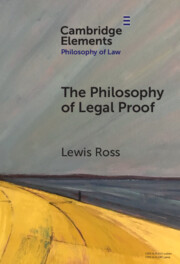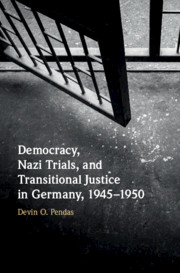Refine search
Actions for selected content:
38 results
5 - Inquisition and Trial Records
- from Part I - Approaches and Evidence
-
-
- Book:
- The Cambridge Companion to Christian Heresy
- Published online:
- 17 July 2025
- Print publication:
- 31 July 2025, pp 97-112
-
- Chapter
- Export citation
17 - Wyclif, Lollards and Popular Heresy
- from Part II - Case Studies
-
-
- Book:
- The Cambridge Companion to Christian Heresy
- Published online:
- 17 July 2025
- Print publication:
- 31 July 2025, pp 345-362
-
- Chapter
- Export citation
9 - Archiving the Holocaust
-
-
- Book:
- The Cambridge History of the Holocaust
- Published online:
- 16 May 2025
- Print publication:
- 12 June 2025, pp 174-197
-
- Chapter
- Export citation
6 - Time Trials
-
-
- Book:
- The Board of Longitude
- Published online:
- 11 April 2025
- Print publication:
- 17 April 2025, pp 122-156
-
- Chapter
- Export citation
5 - The Birth of the Board of Longitude
-
-
- Book:
- The Board of Longitude
- Published online:
- 11 April 2025
- Print publication:
- 17 April 2025, pp 89-121
-
- Chapter
- Export citation
Justice in the Time of Cholera
-
- Journal:
- Asia-Pacific Journal / Volume 22 / Issue 3 / March 2024
- Published online by Cambridge University Press:
- 14 March 2025, e3
-
- Article
-
- You have access
- Open access
- Export citation
Preparing better: Accelerating COVID-19 Therapeutic Interventions and Vaccines (ACTIV) therapeutics trials lessons learned: A call to the future
-
- Journal:
- Journal of Clinical and Translational Science / Volume 8 / Issue 1 / 2024
- Published online by Cambridge University Press:
- 15 October 2024, e150
-
- Article
-
- You have access
- Open access
- HTML
- Export citation
A Dynamic Theory of Prosecutorial Roles in Adversarial Trials
-
- Journal:
- Asian Journal of Law and Society / Volume 11 / Issue 2 / June 2024
- Published online by Cambridge University Press:
- 03 June 2024, pp. 152-177
-
- Article
-
- You have access
- Open access
- HTML
- Export citation

The Philosophy of Legal Proof
-
- Published online:
- 23 April 2024
- Print publication:
- 16 May 2024
-
- Element
- Export citation
7 - Procedural Law
- from Part III - The Biblical Laws
-
-
- Book:
- The Cambridge Companion to Law in the Hebrew Bible
- Published online:
- 11 April 2024
- Print publication:
- 18 April 2024, pp 138-157
-
- Chapter
- Export citation
23 - Decisions Surrounding the Use of Expert Testimony
- from Part III - Trial Phase Decision-Making
-
-
- Book:
- The Cambridge Handbook of Psychology and Legal Decision-Making
- Published online:
- 22 February 2024
- Print publication:
- 29 February 2024, pp 355-364
-
- Chapter
- Export citation
6 - Does It Work?
-
- Book:
- Seeking Justice
- Published online:
- 09 June 2023
- Print publication:
- 15 June 2023, pp 143-165
-
- Chapter
- Export citation
4 - Revolution on Trial
-
- Book:
- Revolution and Political Violence in Central Europe
- Published online:
- 18 June 2021
- Print publication:
- 01 July 2021, pp 120-165
-
- Chapter
- Export citation
5 - Inventing Genocide in the 1940s
- from Part I - The Language of Transgression
-
- Book:
- The Problems of Genocide
- Published online:
- 07 January 2021
- Print publication:
- 04 February 2021, pp 201-240
-
- Chapter
- Export citation
Chapter 9 - Gender
- from Part II - Approaches
-
-
- Book:
- A History of American Puritan Literature
- Published online:
- 24 September 2020
- Print publication:
- 15 October 2020, pp 189-210
-
- Chapter
- Export citation

Democracy, Nazi Trials, and Transitional Justice in Germany, 1945–1950
-
- Published online:
- 11 September 2020
- Print publication:
- 24 September 2020
6 - Abductions
- from Part II - Ways to Marriage
-
- Book:
- Marriage in Ireland, 1660–1925
- Published online:
- 04 June 2020
- Print publication:
- 25 June 2020, pp 181-216
-
- Chapter
- Export citation
4 - Images and Practices in the New Courts
-
- Book:
- The Lawful Empire
- Published online:
- 25 November 2019
- Print publication:
- 05 December 2019, pp 148-180
-
- Chapter
- Export citation
7 - Dealing with Unrest
-
- Book:
- The Lawful Empire
- Published online:
- 25 November 2019
- Print publication:
- 05 December 2019, pp 248-274
-
- Chapter
- Export citation
5 - Seeking Justice
-
- Book:
- The Lawful Empire
- Published online:
- 25 November 2019
- Print publication:
- 05 December 2019, pp 181-213
-
- Chapter
- Export citation
